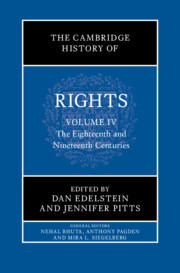Book contents
- the cambridge history of rights
- The Cambridge History of Rights
- The Cambridge History of Rights
- Copyright page
- Contents
- Figures
- Contributors to Volume IV
- General Introduction
- A Note on Translations
- Introduction to Volume IV
- Part I A Revolution in Rights?
- 1 Barbeyrac’s Intervention
- 2 Rights and the Bourgeois Revolution
- 3 Social Rights
- 4 Enlightenment Theories of Rights
- 5 Rights, Property, and Politics
- 6 Antislavery in the Age of Rights
- 7 Enlightenment Constitutionalism and the Rights of Man
- 8 Fundamental Rights at the American Founding
- 9 Declarations of Rights
- 10 The Rights of Women (or Women’s Rights)
- 11 The Image of Rights in the French Revolution
- Part II Postrevolutionary Rights
- Part III Rights and Empires
- Index
- References
9 - Declarations of Rights
from Part I - A Revolution in Rights?
Published online by Cambridge University Press: 22 January 2025
- the cambridge history of rights
- The Cambridge History of Rights
- The Cambridge History of Rights
- Copyright page
- Contents
- Figures
- Contributors to Volume IV
- General Introduction
- A Note on Translations
- Introduction to Volume IV
- Part I A Revolution in Rights?
- 1 Barbeyrac’s Intervention
- 2 Rights and the Bourgeois Revolution
- 3 Social Rights
- 4 Enlightenment Theories of Rights
- 5 Rights, Property, and Politics
- 6 Antislavery in the Age of Rights
- 7 Enlightenment Constitutionalism and the Rights of Man
- 8 Fundamental Rights at the American Founding
- 9 Declarations of Rights
- 10 The Rights of Women (or Women’s Rights)
- 11 The Image of Rights in the French Revolution
- Part II Postrevolutionary Rights
- Part III Rights and Empires
- Index
- References
Summary
The declarations of rights issued during the American and French revolutions are the most important outcomes of the eighteenth-century’s debates about natural rights. Concise and clear in their language, these declarations distilled decades of theorizing into easily understood axioms meant to make citizens aware of their rights and of their entitlement to participate in the making of the laws under which they lived. The eighteenth-century declarations on both sides of the Atlantic were drawn up by legislators determined to protect the institution of slavery that so flagrantly contradicted their sweeping statements about natural rights, and they were not intended to grant women equal rights with men. Their expansive language, however, provided a basis for excluded groups to formulate demands that rights be extended to them, even if the authors of the declarations had not intended to do so. The most influential of these documents, the 1789 French Declaration of the Rights of Man and of the Citizen, used sweeping, universal language. Intended as temporary, it was swiftly canonized as the embodiment of the principles of the French Revolution. The more radical French Declaration of 1793 incorporated social rights to welfare, work, and education. Napoleon rejected the idea of including a declaration of rights in the constitution he imposed in France 1799, but the 1948 Universal Declaration of Human Rights showed the lasting power of the tradition inaugurated with the Virginia Declaration of 1776.
Keywords
- Type
- Chapter
- Information
- The Cambridge History of Rights , pp. 200 - 227Publisher: Cambridge University PressPrint publication year: 2024

